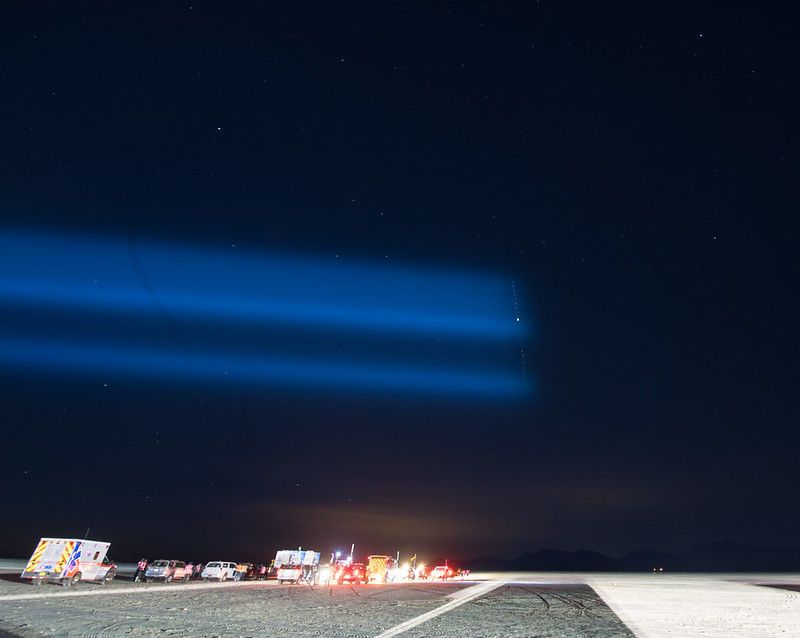Is it time to deliver yet? —
“The design changes were, I would say, minimal.”
Eric Berger
– Aug 7, 2023 9:07 pm UTC

Enlarge / The Boeing CST-100 Starliner spacecraft is seen landing in this 30-second exposure in 2019.
NASA/Aubrey Gemignani
A Boeing official said Monday that the company has delayed a crewed flight test of its Starliner spacecraft until at least March 2024.
The manager for the company’s Commercial Crew Program, Mark Nappi, said the spacecraft should be ready for flight by early March, or seven months from now. However, Nappi said that date is conditional on availability of an Atlas V rocket, provided by United Launch Alliance, and an opening in NASA’s visiting vehicles schedule.
According to NASA’s internal schedule, there is a docking port available from early April to late June 2024 on the International Space Station. So barring a schedule change to delay a cargo mission, the likely no-earlier-than launch date for Starliner’s crewed test flight is April 2024.
Delays and delays
Boeing has reported $1.1 billion in losses for its Starliner program, which is one of two vehicles that NASA helped support development of to fly astronauts to the space station. The other vehicle, SpaceX’s Crew Dragon spacecraft, flew its crew test flight in May 2020. Dragon’s seventh operational mission, Crew-7, is due to launch in about two weeks.
Starliner has faced a more difficult development path. The vehicle’s first uncrewed test flight narrowly averted disaster in December 2019, and due to software issues, Boeing agreed to fly a second test flight without astronauts on board. That mission took place in May 2022, and Starliner successfully docked with the space station.
That set the stage for a crewed test flight this summer, with Sunita Williams and Butch Wilmore on board. However, in late May, just weeks before this mission was due to launch, Boeing and NASA discovered two serious problems—with the vehicle’s parachutes and flammable tape inside the spacecraft.
On June 1, Boeing announced that it was “standing down” to investigate these issues. NASA also said it would require some independent investigations.
Chutes and flammable tape
In the two months since then, Boeing and NASA have been busy. During a teleconference with reporters on Monday, Nappi and the leader of the Commercial Crew Program for NASA, Steve Stich, provided updates on what has transpired since the eye-raising announcement on June 1 of two major problems identified so close to launch.
Nappi said workers have started removing the flammable tape from inside the spacecraft. This glass cloth tape was wrapped around wiring inside the spacecraft to protect it from chafing and rubbing in flight. Several pounds of tape have been removed from Starliner so far.
Perhaps the more significant issue, from a schedule standpoint, are changes to Starliner’s parachutes. At issue were “soft link” joints in the canopy of the parachutes that were found to not have a high enough safety factor. Nappi said the parachute’s manufacturer, Airborne, is fabricating a new version of the parachute joints using a stronger Kevlar material. Boeing plans to conduct a drop test of this new parachute in mid- to late-November, which would leave time for analysis ahead of a launch next spring.
Nappi said he is confident in the timeline left to complete these tasks, saying the work is fairly “straightforward.”
Tests and reviews
When SpaceX decided to change to a more rigorous parachute design for its Crew Dragon vehicle in 2019, going from the “Mark 2” to “Mark 3” parachute, it had to repeat its entire test series. This process, consisting of about two dozen drop tests from various altitudes, took the better part of a year.
Stich, the NASA official, said the space agency was only requiring Boeing to complete a single additional test to verify the performance of its upgraded parachute. SpaceX’s modifications of its parachutes were “significant,” he said. Boeing’s modifications by contrast are fairly simple, Stich said.
“We felt like we only needed one test… given how close both the soft-link redesign and the joint redesign were to what we have already tested in all the previous parachute drop tests.” he said. “The design changes were, I would say, minimal as opposed to what we had for Dragon, which was a, really, a wholesale change in the canopy.”
In addition to the hardware work, Boeing must also comply with three separate investigations. According to Stich, there is an “independent team” at Boeing reviewing the company’s actions. In addition, NASA’s chief engineer, Joseph Pellicciotti, has interviewed every one of Starliner’s subsystem managers to ensure there are no other potential surprises looming. Finally, Pellicciotti, his deputy, and the NASA Engineering & Safety Center have been conducting their own independent review of Starliner’s soundness.
All of these assessments must be completed before NASA convenes a flight-readiness review and determines that Starliner is finally ready to take flight with astronauts on board.
>>> Read full article>>>
Copyright for syndicated content belongs to the linked Source : Ars Technica – https://arstechnica.com/?p=1959382































